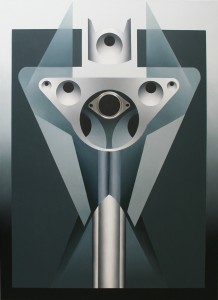« Cyclope » (Cyclops)
Rosemarie Krefeld
2013
100 cm x 73 cm
Oil on canvas
The painting “Cyclops” is a central composition of geometrical forms in bluish grey and silver grey tones that give the impression of metal. This metal effect results of the seamless gradient from dark grey to white. It is due to Rosemarie’s passion for machines, especially engines. During her longstanding studies of machine fragments, she observed that metal parts have often a similarity to body forms. Out of these elements she builds anthropomorphic figures in the image space.
The point of departure in the “Cyclops” painting is a real integrated metal seal from Renault. Its form is close to a rhombus with round angles. It contains small round holes in the sideward tips, originally the screw holes. The middle of that piece is a big round hole. Rosemarie repeats the round black holes, surrounded by white to grey gradient circles, so that they are looking like eyes. The rhombus converts to approximate triangles, which might build the torso.
A vertical accent is given by something like a metal tube in the lower part of the painting. It can be read as the trunk to the giant’s body. Extended in darker grey, this rod crosses the lower part of the torso and guides to the head, which is looking like a motor piston. Here integrated is another eye: the one eye that characterises Cyclops. On each side of the body there is a transparent approximate triangle, giving the heavy giant some ease.
Rosemarie’s approach evokes constructivism, like artistic form of abstract art, which does not reduce a real object, but constructs out of geometric forms. However the result is not a pure abstract painting: in conjunction with the title one might see the one-eyed, weapon forging “Cyclops” of the Greek mythology.
Rosemarie Krefeld
Born in Berlin, Rosemarie lives and works since many years in Antibes, South of France. She had numerous exhibitions in renowned galleries, especially at the Côte d’Azur.
Her style is strongly individual, independent from movements, styles or artistic groups, even though she studied art history and was always in contact with other artists. The very precisely carried out paintings mostly show a kind of metal effect. This is truer for the ones of the 1980ies, which appear to be often machines or part of machines. But even the works from the 1990ies and the first decade of the 21st century, whose subjects include more often persons, archetypes or Saints refer to this style. The human bodies are composed by metal tubes or engine elements, or are surrounded by them.
Since some years Rosemarie returned to her beloved machines, but now she includes often real metal parts, which are reflected by the paintings. In her latest series, exposed in November 2014 at the Zanka-Gallery in Antibes, the subjects are again more often personifications, frequently mythological. Nevertheless the paintings seem to be abstract, build once again out of mechanical elements.
Throughout her artistic career, the dimensions of Rosemarie’s paintings vary. Her oil and gouache paintings are sometimes really small (around 20 cm x 20 cm), but they can also be huge (up to 3 meters high) or something in between.
Rosemarie herself sometimes thinks, that her predilection for metal might be related to one of her ancestors, who had been blacksmith and armourer. And with this we are back to the Cyclops, which were in the Greek mythology as well armourers.
